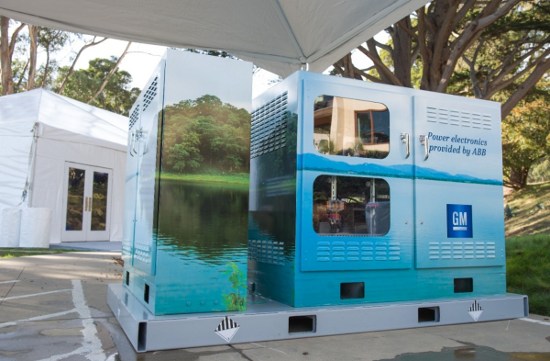 |
| May 28, 2013 | Volume 09 Issue 20 |
Designfax weekly eMagazine
Archives
Partners
Manufacturing Center
Product Spotlight
Modern Applications News
Metalworking Ideas For
Today's Job Shops
Tooling and Production
Strategies for large
metalworking plants
Wheels:
Do electric vehicle batteries have an afterlife? ORNL explores uses
Once they've finished powering electric vehicles for hundreds of thousands of miles, it may not be the end of the road for automotive batteries, which researchers believe can provide continued benefits for consumers, automakers, and the environment.
Five used Chevrolet Volt batteries are at the heart of the Department of Energy Oak Ridge National Laboratory's (ORNL) effort to determine the feasibility of a community energy storage system that would put electricity onto the grid. Over the next year, researchers from ORNL, General Motors, and the ABB Group will conduct studies and compile data using a first-of-its-kind test platform officially commissioned on April 15, 2013. ORNL is based in Oak Ridge, TN.

General Motors and ABB have partnered to produce a prototype back-up power storage unit that repackages five used Chevrolet Volt batteries into a modular unit that becomes an uninterruptable power supply and grid power balancing system. The unit was demonstrated in November 2012 during GM's Electrification Experience in San Francisco, CA. [Photo: Steve Fecht for General Motors]
"With about 1 million lithium-ion batteries per year coming available from various automakers for the secondary market beginning in 2020, we see vast potential to supplement power for homes and businesses," says Dr. Imre Gyuk, manager of the Energy Storage Research Program in DOE's Office of Electricity Delivery and Energy Reliability. "Since these batteries could still have up to 80 percent of their capacity, they present a great opportunity for use in stationary storage devices before sending them to be recycled."
By distributing electrical energy storage into many locations, these units could provide the benefits of a centralized unit but with potentially more localized applications. The ORNL platform provides 25 kW of power and 50 kWh of energy that could potentially provide cost-effective back-up energy to homes and businesses, says Michael Starke of ORNL's Energy and Transportation Science Division.
Given reports like "Drive Green 2020" that estimate production volumes of hybrids, plug-in hybrids, and battery electric vehicles at hundreds of thousands per year before the end of this decade, the potential for energy storage and production is impressive, according to Starke.
Already, GM and ABB have demonstrated how a Chevrolet Volt battery pack can collect electrical energy and feed it back to the grid to deliver supplemental power to homes or businesses. Researchers noted that the system could potentially reduce energy costs and increase grid stability and reliability.
Last year in San Francisco, a GM/ABB energy storage system provided 100 percent of the electricity needed to power a temporary structure for several hours. A similar application could one day power a group of homes or small commercial buildings during a power outage or help make up for gaps in solar, wind, or other renewable power generation.
"This project with Oak Ridge will enable us to start obtaining data to see if Volt batteries can perform by providing energy cost savings through peak load and time-of-use energy management," says Bill Wallace, director of GM battery systems engineering.
The ORNL platform is the culmination of three years of research that began with a scoping study to determine the market for energy storage on the grid. This test moves research from the development stage to testing, which will provide researchers with the ability to quantify the technical and cost performance of the system under various real-world conditions.
"In the future, distributed energy storage on the electric grid may become as commonplace as batteries in cell phones by providing greater energy reliability and reduced energy cost to the consumer," says George Andrews of ORNL's Power and Energy Systems Group.
Funding for this work was provided by DOE's Office of Electricity Delivery and Energy Reliability. The Office's Energy Storage Research Program supports research on a wide spectrum of storage applications and a broad portfolio of technologies. Ongoing work with ORNL explores the feasibility of using re-purposed EV batteries for stationary storage applications.
Source: ORNL
Published May 2013
Rate this article
View our terms of use and privacy policy
